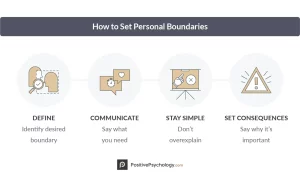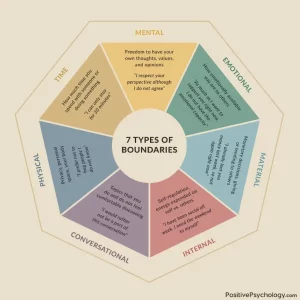Having well-defined boundaries is fundamental in sustaining affirming and polite relationships, safeguarding the well-being of all parties involved. In the context of this thorough instruction, we will examine the domain of frontiers, their meaning, and strategies to build and nurture them for individual care. In addition, we will investigate how boundaries can help foster healthy connections.
What Are Boundaries?
In elementary terms, boundaries are restrictions or borders that set us apart as unique individuals (According to Katherine’s work published in 2010 on page 14). While our physical boundaries are evident, such as our skin, Additionally, we possess interpersonal boundaries that dictate how comfortable we feel around other people.
Depending on culture, personality, and social context, these interpersonal boundaries may differ. Consider how the conduct that is deemed appropriate in a professional gathering may lose its importance when placed in a relaxed scenario among close acquaintances. Setting boundaries Contributing to the establishment of our desired outcomes from ourselves as well as from individuals involved, it supports us in different relationship contexts.

How to Set Healthy Boundaries
Creating healthy boundaries Necessitates both self-awareness and skilled communication. Follow these steps to establish and maintain healthy boundaries:
Be Clear and Direct:
Ensure clarity and directness while communicating your boundaries, refraining from raising your voice.
Express Needs Positively:
State your needs or requests in positive terms, focusing on what you desire rather than what you don’t want.
Take into consideration that the act of asserting boundaries can bring about sensations of discomfort, including guilt or shame, especially if you have had previous struggles with establishing healthy limits or codependent relationships.
Don’t forget, having healthy boundaries does not mean erecting walls; instead, it means implementing guidelines that prioritize self-care and safeguard the integrity of your relationships.
Examples of Healthy Boundaries
Here are some examples of healthy boundaries:
Saying “No”:
Opting out of tasks or activities that make you uneasy or hold no appeal to you
Expressing Emotions Responsibly:
Openly sharing your feelings while being respectful towards others.
Addressing Issues Directly:
Having a Direct Conversation about issues with the individual concerned, instead of involving a third party.
Clarifying Expectations:
Clearly stating your expectations rather than assuming others will understand them.

Personal and Emotional Boundaries
Preserving personal and emotional boundaries is vital for overall welfare. significantly impacts one’s overall health and wellness. How emotionally accessible we are to others is shaped by our emotional boundaries. While it is important to extend support to others, we must prioritize self-care. We should acknowledge that being constantly accessible may not always be possible to meet others’ emotional needs.
Burnout and feelings of resentment can be avoided by establishing limits in emotional connections. Consistently crossing these boundaries might indicate an imbalanced or unhealthy relationship that warrants assessment and possible modification.
Creating limits is essential in various domains of life, including work settings, friendly associations, and close bonds. At work, clearly communicate your availability and preferred working arrangements. In friendships, understand your personal limits and prioritize self-care. Regarding close bondings, clear communication about mutual needs and expectations is essential.
Setting Boundaries in Different Contexts
“Establish Limits, Achieve Harmony” by Nedra Glover Tawwab is a valuable resource for individuals struggling with setting boundaries. By presenting genuine instances for analysis and incorporating active exercises, the book enables readers to discover their own communication weaknesses while successfully establishing and sustaining appropriate limits. A central theme explored in the book is the value of having boundaries in promoting healthy relationships and empowering individuals to prioritize their overall well-being.
“Set Boundaries, Find Peace”: A Review
With the intention of aiding in defining and asserting boundaries, free Positive Relationships PDF worksheets are available. The areas addressed in these worksheets encompass visualizing boundaries, engaging in self-reflection, asserting oneself through refusal and establishing internal limits.
Positive Relationship Resources
PositivePsychology.com gives you access to diverse tools for cultivating and preserving thriving relationships, which encompass worksheets and articles centered around conflict resolution, boosting emotional intelligence, as well as additional subjects.
Conclusion
Setting healthy boundaries is a crucial life skill helping to prioritize self-care and cultivate affirmative connections. Effectively communicating boundaries is vital and also have consideration for the limits of others. By establishing and maintaining healthy boundaries, Promoting robust, satisfying connections while also safeguarding our mental and emotional wellness is what we achieve.










